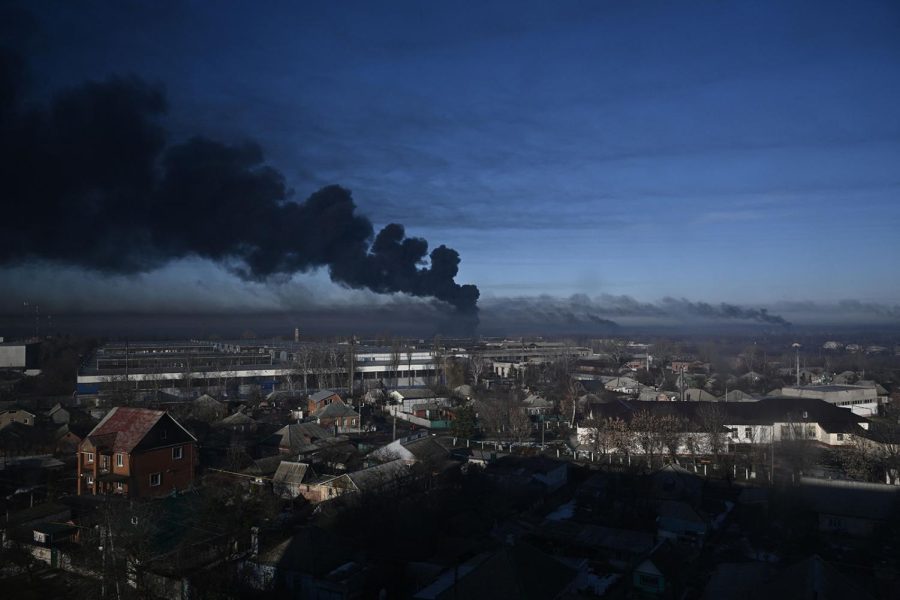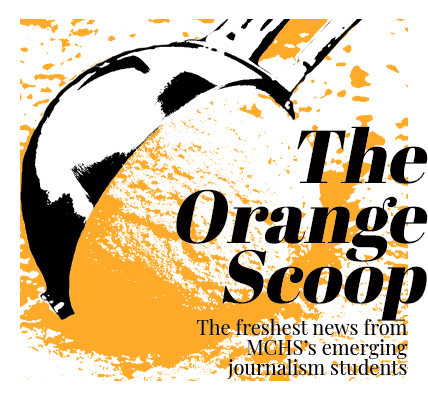Russian forces launch attack on Ukraine
Despite sanctions from NATO countries, Russia’s aggression against its neighbor persists, causing panic among nations
Aris Messinis / AFP via Getty Images / TNS
Black smoke rises from a military airport in Chuguyev near Kharkiv, Ukraine, on Feb. 24, 2022.
February 25, 2022
On Thursday, a Russian attack on Ukraine began with missile attacks near Kyiv, Ukraine’s capital, and the Russian border. There have been around ten civilian deaths, 40 Ukrainian soldier deaths, and many more injured.
According to a BBC article, Ukraine declared martial law and severed diplomatic relations with Russia. Countries surrounding Ukraine are declaring a state of emergency in order to aid Ukrainian refugees. Romania is prepared to receive up to 500,000 Ukrainian refugees, according to Vasile Dincu, Romania’s Defense Minister. Moldova has received 4,000 refugees, as of Thursday.
Ukrainian President Volodymyr Zelensky and the military reported that Ukraine was attacked from three sides — from the North through Kharkiv, Luhansk in the East, and Crimea in the South. While missile attacks were experienced throughout Ukraine, the fighting is concentrated in the East, where Russian-backed separatists are located.
According to a speech given by Russian President Vladimir Putin, the goal of the invasion is to “demilitarize” and “denazify” Ukraine. He claims the Ukrainian government is corrupted by far-right nationalists and neo-Nazis who will never forgive Crimea for voluntarily reuniting with Russia.
“The current events have nothing to do with a desire to infringe on the interests of Ukraine and the Ukrainian people,” said Putin in his speech. “They are connected with defending Russia from those who have taken Ukraine hostage and are trying to use it against our country and our people.”
NATO allies and the United Nations have expressed concern over the invasion of Ukraine. UN Secretary-General Antonio Guterres said, “President Putin, in the name of humanity, bring your troops back to Russia.”
Following Russia’s “unprovoked and unjustified” attack on Ukraine, U.S. President Joe Biden introduced new sanctions on the Russian economy. Four Russian banks, including the two largest, no longer have access to the U.S. financial system. Other G-7 countries have introduced their own sanctions, impacting Russia’s ability to use dollars, pounds, euros, and yen.
“Putin is the aggressor,” said Biden in a speech. “Putin chose this war and now he and his country will bear the consequences.”
Putin responded to sanctions with, “No matter who tries to stand in our way or all the more so create threats for our country and our people, they must know that Russia will respond immediately, and the consequences will be such as you have never seen in your entire history.”
Prior to the attack, Putin had recognized Luhansk and Donetsk, two regions of Ukraine, as independent states. On Monday, he announced that troops would be deployed to the regions for “peacekeeping operations” in a speech.
At the time, around 190,000 Russian troops were surrounding Ukraine, with medical supplies and blood being brought to the areas.
Recognizing the beginnings of a Russian invasion, Biden had introduced a series of sanctions on Nord Stream 2 AG, a firm whose parent company is Russia’s Gazprom. The German government also halted certification of the pipeline on Tuesday. Biden had called this the “first wave of sanctions,” warning of more severe ones if Russia were to invade Ukraine or any NATO ally.
Tensions between Russia and Ukraine can be traced back to 2008, when Ukraine expressed interest in joining NATO. In 2014, further division arose after Ukrainian protestors drove out their pro-Russia president. In attempts to maintain influence and power, Russia invaded Ukraine and annexed Crimea.
Conflict was renewed in 2021 when Russia presented NATO with treaties requesting “security guarantees.” Among these requests were a legally binding agreement for Ukraine to never join NATO and a reduction of NATO troops in Eastern Europe. While NATO rejected these conditions, the United States had attempted to engage in diplomacy with Russia in early 2022. Russia was not satisfied with the compromises, leading to the Ukrainian invasion.











